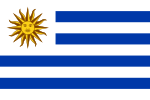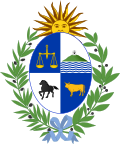 | José Enrique Rodó is a small town in the Soriano Department of western Uruguay. The town is located on Route 2, about 26 kilometres (16 mi) northwest... 4 KB (268 words) - 11:20, 13 December 2023 |
footballer José Enrique Porto (born 1977), Spanish Paralympic cyclist José Enrique Ramírez (born 1992), Dominican Republic baseball player José Enrique Rodó (1872–1917)... 1 KB (172 words) - 20:41, 13 June 2023 |
 | itself and belongs to Punta Carretas. The name "Rodó" has been given in memory of José Enrique Rodó, an important Uruguayan writer whose monument is... 5 KB (338 words) - 16:29, 21 October 2023 |
Ariel is a 1900 essay by Uruguayan author José Enrique Rodó. Drawn from William Shakespeare's The Tempest, in which Ariel represents the positive, and... 4 KB (472 words) - 20:04, 5 February 2024 |
 | a portable beverage that Uruguayans take to all manner of places. José Enrique Rodó (1871–1917), a modernist, is considered Uruguay's most significant... 162 KB (14,976 words) - 14:55, 28 April 2024 |
 | Montevideo (section Parque Rodó) neighborhood itself and belongs to Punta Carretas. The name "Rodó" commemorates José Enrique Rodó, an important Uruguayan writer whose monument is in the southern... 210 KB (19,735 words) - 01:46, 28 April 2024 |
Isabella II José Enrique Rodó, Uruguayan essayist José Antonio Rodríguez Muñoz, Spanish flamenco guitarist, composer and music professor José Rodrigues... 125 KB (12,390 words) - 15:01, 19 April 2024 |
the god he believes in. In the 1900 essay Ariel by Uruguayan author José Enrique Rodó, Caliban is the antagonist. In 1933, Ralph Richardson played Caliban... 17 KB (2,173 words) - 19:37, 28 April 2024 |


